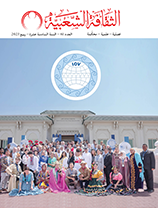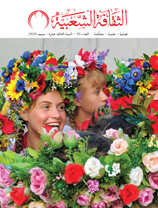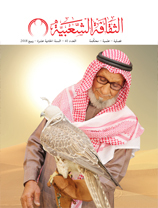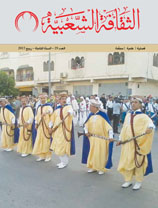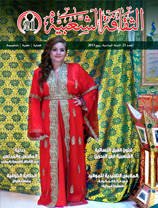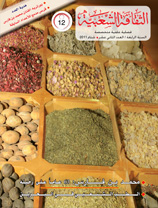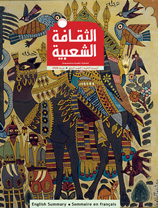Arabic Music: A Vision Combining Heritage and Philosophy
Issue 8

Barakat Mohammed Morad (Egypt)
Poetry in the pre-Islamic era was considered as a manifestation of Arabic geniuses, and music was connected to Arabic language because the latter is basically a musical language that depends on the hearing senses, a fact attributed to the connection between music and the Holy Koran, the reading of which produces a musical rhythm whose echoes reverberate between reader and listener: a proof of miraculous nature of Koran. The author states that the first book dedicated to sounds and songs was entitled “Kitab Al-Nagham” (The Book of Melody). This book appeared in the period of Umayyad Caliphate and was written by the author Younis Al-Kateb, a man who preceded Abu Al-Faraj Al-Isfahani in music and song composition for almost two hundred years. Younis also wrote another book entitled “Al-Mughanniat” (Ladies-Singers). Since then, Arabic books dedicated to song and singers began to flow out, and this process continued throughout the era of Abbasid Caliphate. The most famous books were written by prominent scholars, such as Al-Khalil Ibn Ahmad, Al-Kindi, Al-Farabi and Saffii Addin Abd-Elmo’men Al-Armawi. In his ancient book “History of Arabic Music”, The British orientalist Henry George Farmer quoted tens of scholarly references about song and music, which so far either remained in their original manuscripts or were lost, leaving the titles and the authors in the Lists of Lost Books. Henry Farmer begins his book with the explanation of the big difference between the eastern music, which is perceived horizontally and the western music, which is perceived vertically. The first one is characterized by melody, rhythm and tone decoration, all of which seem strange for the western listener. The said difference, though, was not huge before the tenth century, because all kinds of music used the same Pythagorean and originally Semitic scale. This scale was designed on the basis of music of celestial bodies and on the harmony of numbers, where musical composition was unknown. The difference showed up when Arab people invented a method for musical analogy, thus acquiring an idea about melody composition. In fact, Arab people transferred the manufacturing of musical instruments into a noble art. Treatises were written, and some cities, such as Seville, were famous for nurturing this profession. Moreover, there are several clues which indicate that Arab People were both inventors and improvers of musical instruments. Despite the existence of some musical records since the ninth century, musical composition was a sort of hearing by ear, which explains why some composers and poets claimed that devils inspire their musical talents. Literature on music, which was rich in content, was full of stories and collections dedicated to songs, books about musical instruments, musical laws and beauty, biographies and life histories of singers and musicians. The most prominent musical authors were Al-Masoudi (d. 957), who wrote “Muruj Al-Dahab” (Meadows of Gold), Al-Isfahani (d. 967), who wrote a book entitled “Al- Aghani” (The Songs), and in the west we meet with “Al-Aqd Al-Fareed” (The Unique Contract) by Ibn Abd Rabbih (d. 940). Yahia Al-Khudj Al-Mursi also wrote a similar book about songs in the twelve century, thus imitating Al-Isfahani’s abovementioned book. The authors of musical theories were led by Younis Al-Kateb (d. 765), who was followed by Al-Khali Ibn Ahmad, author of the science of prosody (d. 791), and also by Issaq Al-Mosuli (d. 850), who was an innovator, a doctrine founder, and an inventor of rhythms and melodies. Through the translation activity in that period, Arab had acquainted with some ancient Greek treatises about music and science of acoustics, such as “Principles of Melody” and the “Rhythm” by Aristoxenus, “Introductions to Harmonics and the Zither’s Solo”, written by Euclid, “Music” by Nicomachus and the “Treatise of Harmonics” by Ptolemy. Among the authors of theoretical music, which was affected by Greeks, was the Arabic philosopher Al-Kindi (d. 874). He had seven treatises on the theory of music, in which he spoke about sensations of tone, types of keys and melodies, and proved that the Arabic song is not Persian or Romanian but rather exists by itself, though Arabs had quoted some methods that those people used in their melodies and had learned from them how to use the lute. In the hands of Arab singers, however, the lute was arabized, becoming completely different from its counterparts in Persia and Rome. “Every nation, as Al-Kindi puts it, has its own method of playing lute that is very different from the methods of other nations”. Nevertheless, many books, which were written by Al-Kindi, were lost and only three books remained, with some of his manuscripts, in the museums of Europe. People told legends that linked the invention of lute with the name of Al- Farabi. They claimed that he created an instrument whose strings produce a very comic and laughable melody upon their movement in a certain manner. It is possible that the people who distributed this kind of rumor saw an ancient instrument in his book that he described as a rectangular tool, over which a calibrated ruler was fixed so as to measure the different kinds of sensations of tone. Avempace, who was the most prominent theoretical figure of science of music in Andalusia, wrote a treatise in music which was as famous in the west as was Al-Farabi theory in the Islamic east. Averroes, however, described the theories of tone, commentating on “Deanima”, a book by Aristotle about the sole. The author also refers to the sophists who enriched song and music in the Arab World with different keys and melodies. The melodies that we sing today are not solely played by implementing the keys that were developed by Al-Mosuli or Ibn Jame’e in the bright era of Baghdad. They are rather wider, more versatile and lively, thanks to these two men, because the dissemination of their methods in such countries as Egypt, Greater Syria, Iraq, Persia, Turkey and India helped different types of songs and music interfere and intermix in these countries. It also contributed to the creation of an artistic unity based on these types that gives relaxation to the ears and cheers up the souls of all people in the Islamic World, despite the existing differences between languages and moods.











